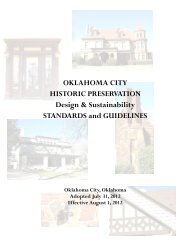OKC Plan, 2000-2020 - City of Oklahoma City
OKC Plan, 2000-2020 - City of Oklahoma City
OKC Plan, 2000-2020 - City of Oklahoma City
You also want an ePaper? Increase the reach of your titles
YUMPU automatically turns print PDFs into web optimized ePapers that Google loves.
Urban Growth Area<br />
The Urban Growth Area (shown on the Development Areas Map, page 10) includes areas <strong>of</strong><br />
more recent and on-going development which are served by the three basic urban services—public<br />
provided water supply, sewage treatment, and fire protection or where such services will be made<br />
available within the time period covered by the <strong>Plan</strong>. Predominant uses are single-family homes,<br />
apartments <strong>of</strong> moderate densities, regional and community shopping centers, low-rise <strong>of</strong>fice<br />
buildings and industrial development in selected areas.<br />
Within the Urban Growth Area residential densities usually exceed one dwelling unit per<br />
acre. To achieve more compact residential areas, large-scale residential developments consisting <strong>of</strong><br />
a mixture <strong>of</strong> housing types and densities may range up to eight dwelling units per acre for an overall<br />
project density.<br />
Development is generally suburban in scale and modern, having mostly occurred over the<br />
past 30 years. Construction markets are healthy, highway access is good, and household incomes<br />
are moderate to high. Much bypassed or undeveloped land remains.<br />
Direction<br />
Encourage a variety <strong>of</strong> land uses, intensities, and development patterns, including the use <strong>of</strong> grid<br />
plats, to provide more diverse residential options, a wider variety <strong>of</strong> commercial goods and<br />
services and a more efficient use <strong>of</strong> public services.<br />
Promote high-quality, desirable residential neighborhoods which are compact and pedestrianfriendly<br />
with a mix <strong>of</strong> uses within walking distance. Neighborhood streets should be safe for<br />
children, comfortable for bicycling, and pleasant for walking.<br />
Promote high-quality commercial, <strong>of</strong>fice, institutional, and multi-family residential development<br />
which is compatible with adjoining land uses, adequately served by the transportation network<br />
and other public services, and scaled to the size <strong>of</strong> projected markets in the surrounding area.<br />
Such development should contribute to, rather than detract from, the area’s appearance and<br />
desirability, preserve natural features and topography, and have positive fiscal and other impacts<br />
on the community.<br />
Build and maintain a high-quality transportation system within the Urban Growth Area that is<br />
adequate to the traffic needs generated by adjoining development, is cost-effective to build and<br />
maintain, provides a full range <strong>of</strong> transportation alternatives, and enhances rather than detracts<br />
from the Area’s appearance and livability.<br />
Require new development to use public water supply, sewage disposal and fire protection<br />
according to established policies.<br />
14

















